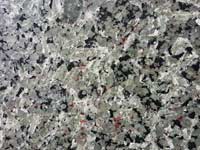Russia, 199034, St. Petersburg, Line 14th V.O., house 7, letter A, BC "Preobrazhensky"

(812) 322-09-40
(812) 322-34-40
Rock Hibinit
Effective specific activity of natural radionuclides: Class I. I class. According to its radiological characteristics, khibinit belongs to class I, which means that it can be used without restrictions in all types of building and finishing works.
Features of appearance: The color tone of Khibinit can vary from light to dark shades of gray-green. Green color purity 9-10%, color tone 558 nm, lightness 16-19%. Contrast inclusions of raspberry and brown-red eudialyte (their number can be different, up to a complete absence) and crystals of black aegirine and harfvedsonite add special beauty to this green stone. Sometimes in the rock there are caverns. The structure is uniform medium and coarse-grained. The texture is massive trachytoid. This unique type of natural stone belongs to the first class of decorative (34-35 points on the scale of the qualimetric system). The Lovchorr Khibinites are an industrial analogue of the Aikuayvenchorr field rocks. According to the commercial classification, the stone belongs to the group of “colored granites” and surpasses foreign analogues in decorativeness, for example, the Portuguese nepheline syenite “St. Louis”.
Scope: Hibinit, due to its good physicomechanical properties and high decorative effect, can be used both for the manufacture of all kinds of products intended for operation in the open air, and for all types of interior decorating. Plates for facing socles and facades of buildings, balustrades and stairs, parapets, pillars, columns, pedestals and pedestals, ritual and memorial articles, parts for the installation of fountains and other small architectural forms. Hibinit is perfect for finishing respectable buildings, facades and interiors of the subway, ceremonial rooms, as well as temple complexes, hotels, banks, restaurants. It was used in the decoration of the floors and walls of the hotel "Bashkiria" in Ufa, they partially faced the facade of the cultural center to them. Su Meyerhold in Moscow, Rublevsky shopping and office center in Moscow (facade elements, steps, window sills, tabletops), in multicolor floor tiles in the Savings Bank Hall at 5 Furshtadskaya Street and atrium floor plates on Nevsky Prospect, 25, as well as in individual elements Ladoga station.
Technological features: Khibinit is similar in its strength characteristics to granite. But in its composition there is no quartz, which makes it much more pliable in processing. In operation Khibinit extremely reliable. It is perfectly polished - to a mirror shine, and this is the optimal texture for its processing.







 Site search
Site search


